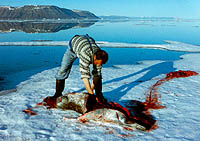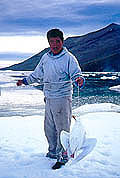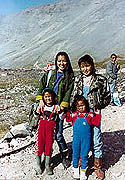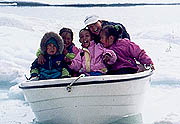 My mother has been painting oil paintings ever since I can remember. Simply painting on canvas was not enough for her; she graced our living room walls and the sliding doors of our bedrooms with her depictions of nature. Perhaps because I was raised in such an environment, I took up oil painting at the age of 18.
My mother has been painting oil paintings ever since I can remember. Simply painting on canvas was not enough for her; she graced our living room walls and the sliding doors of our bedrooms with her depictions of nature. Perhaps because I was raised in such an environment, I took up oil painting at the age of 18.
Eight years ago I moved out of my parents’ home and came to Kyoto with a firm resolve to find out what I was capable of on my own. I wanted to make a new start. Even though I moved from Komatsu to Kyoto, I did not manage to sell my paintings, and led quite a miserable life.
During my second year in Kyoto, in a period of searching for my own colors and subject matter, I came across moso bamboo. “This is it!” I thought. Even though I had never been particularly impressed by bamboo forests, at that time my feelings and the aspect of the bamboo were in perfect harmony; the bamboo seized my spirit and wouldn’t let go.
The thick, strong moso bamboo of a lush green grows straight up to the sky.
In contrast, its dense roots run riot, forming a tangles mass from which they have enough force to break through concrete. I was deeply struck by that weed-like vitality. It seemed to me that bamboo expressed both the appearance and the interior state of human beings. I decided to devote my life to investigating the extent to which expression can derive from the representation of bamboo as human beings.
It was on that day that my craze for bamboo began. I sought and painted the spirit of bamboo, the voice of bamboo, its smell, color and balance, and constantly enjoyed physical contact and conversation with it. In due course I was awarded the prize of the Chunichi Women’s Art Exhibition four years in a row. I was also accepted to and won prizes at exhibitions both in Japan and abroad, and held regular yearly solo exhibitions. During this time I gradually began to receive more orders for my bamboo paintings. In my case, since I sold my paintings to make a living, each time I received an order I did my best to paint a bamboo painting that would please my client.
2

One day, a thought suddenly occurred to me. Was not my will to paint beautiful bamboo, to paint each individual beautiful bamboo tree too much in the forefront, preventing me from painting the true color of the bamboo?
If was going to spend my life as a discerning bamboo artist, I had to have eyes and a spirit that could look at bamboo honestly. I had to maintain the eyes and the spirit of a child to be able to express honestly the impression that the bamboo gave me…
And I wanted to peel off one more layer of skin than there are in the skin I have now. I wanted to see and paint bamboo more honestly. In order to do that it was absolutely necessary for me to change my ideas. I wanted to put my spirit into a state of nothingness. Maybe if I went to a world that was devoid of color, the color of bamboo would appear more vivid.
 That was it! A colorless world – the North Pole or the South Pole. If I was going to go somewhere, I might as well go to the top of the earth, so I decided to go to the North Pole. At the top of the earth’s axis, in a world devoid of color, I wanted to take a fresh look at my paintings and at myself. With this in mind, I eagerly looked up all kinds of information, searched for connections in various places, and ended up aiming to go to the northernmost Inuit village, Siorapaluk. Because it is in Danish territory, I submitted an application to the Danish embassy, and because there is an American base there, I needed a special permit. I spent a hectic time dealing with these formalities, but in the end my wish came true; on June 30, 1991 I left from Narita Airport. For about one month, until July 30, I experienced life in Greenland. I returned to Japan on August 3.
That was it! A colorless world – the North Pole or the South Pole. If I was going to go somewhere, I might as well go to the top of the earth, so I decided to go to the North Pole. At the top of the earth’s axis, in a world devoid of color, I wanted to take a fresh look at my paintings and at myself. With this in mind, I eagerly looked up all kinds of information, searched for connections in various places, and ended up aiming to go to the northernmost Inuit village, Siorapaluk. Because it is in Danish territory, I submitted an application to the Danish embassy, and because there is an American base there, I needed a special permit. I spent a hectic time dealing with these formalities, but in the end my wish came true; on June 30, 1991 I left from Narita Airport. For about one month, until July 30, I experienced life in Greenland. I returned to Japan on August 3.
 3
3
Siorapaluk is located in northern Greenland. This very small village, consisting of only 18 or 19 houses, has a population of only 70, and some 300 dogs. With no electricity, gas, running water or showers, living conditions are far from civilized. I borrowed a tent from a Japanese hunter by the name of Oshima who had been living there for 18 years. I slept outdoors, but sometimes he invited me in for a meal, and looked after me in various ways. I made a few friends, and was invited to each of their houses for dinner. One day, I accompanied Mr. Quartz, a Danish resident, on a three-day seal hunting trip. At the echo of gunshots, a seal desperately tries to get away in order to live. And the hunter pursues it desperately in order to live as well. Watching the hunter cutting up the dead seal on the drift ice, I felt no sense of wonder or cruelty. If it’s for survival there’s no choice in the matter. These people never killed more seals or whales than they needed, and I was deeply moved by how they lived in severe conditions, subject to the laws of nature.

When two young Inuit pulled a young white whale up onto the shore, the villagers gathered seemingly from out of nowhere, and with the knives they were holding they cut the whale’s hide, removed the white blubber and started to eat it. Faces and hands dripping scarlet blood, they exclaimed “mamatto” (delicious) as they filled their smiling mouths. A four-year-old girl was deftly using a knife as she ate. When I tried to eat some in the way in which I had been taught, I found the hide to be crunchy, with a delicious taste like that of abalone meat.
When I climbed up to a rocky outcrop on a hill, an infinite number of appariaho (a migratory bird) were flying around, and crying noisily, they let their droppings fall with abandon. A black fox came close to me and found bird’s nests between some rocks. It went around peering into them one by one. In one valley I saw three of them wandering around together — a scene that made me marvel at being in the great outdoors.
4

At any rate, I returned to Japan having enjoyed to the full life’s harshness, toughness, obstinacy and joy. I had experienced an amazing vitality ? the vitality of a world that glows with unaffected life, of a world without color. As this vitality also relates to bamboo, I learned a lot on the trip.
In order to have a long career as possible as a painter, I want to be as active as possible while I am young ? to not only think of ideas, but to actually put them into practice.
Many people disapproved of my trip to Greenland, but I have an intense personality, and believe that “if I think I can do something, I can do it.”
With the passing years my mind has become that of an adult, but I want my spirit to remain as curious as that of a child. This time I experienced Greenland in summer, so next time I’d like to go in winter. I’m already excited about discovering what life is like there during the three dark midwinter months when the sun doesn’t come out all day, and the temperature drops to 30 to 40 degrees below zero.
Next time I want to bring vegetable seeds. In Greenland vegetables are all imported because there is a preconceived idea that it is not possible to grow them. However, alpine plants bloom in seasons during which the sun comes out, so I think it must be possible to grow vegetables. I will be very happy if I can supplement, however little, the vegetables of the Inuit.
“The bamboo of Kyoto” and “the Inuit of Greenland”.
Both of these have a tough, unyielding vitality. I really feel that I have discovered a deep connection with their splendid lives.

 日本語
日本語 简体中文
简体中文